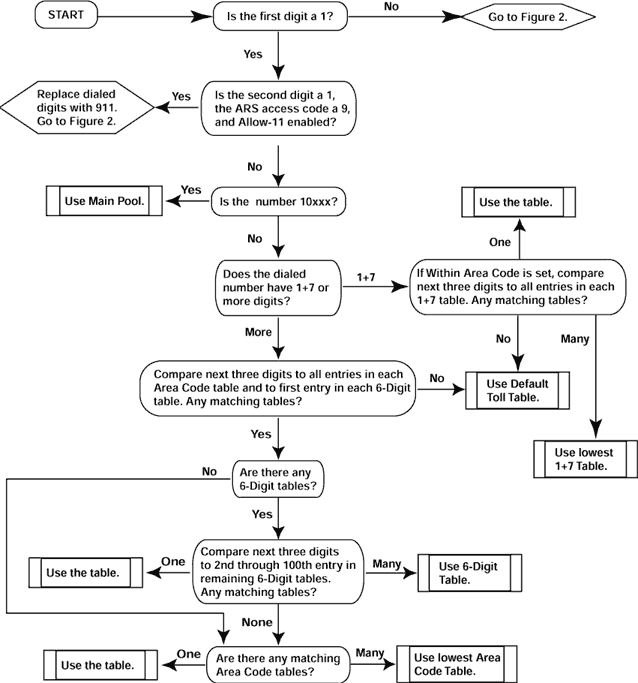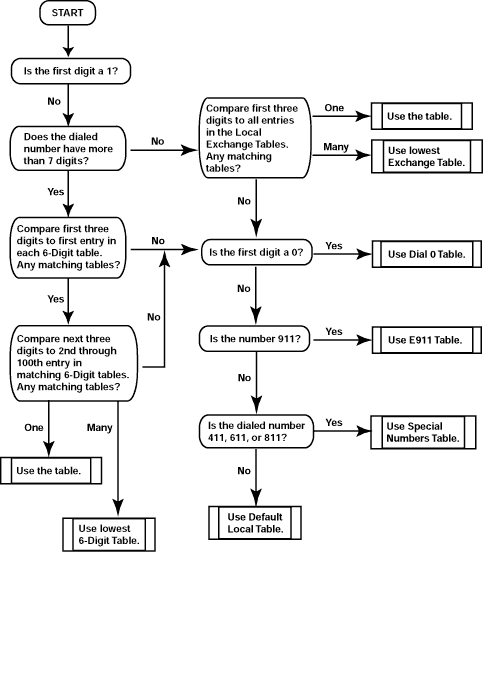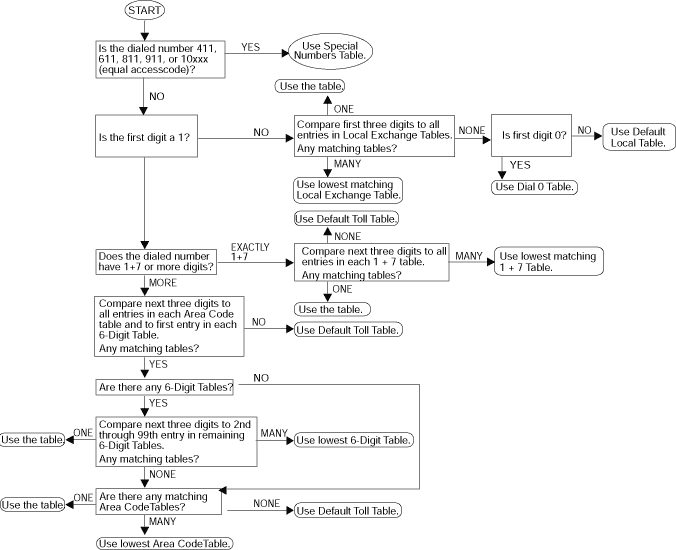| more topics |
Table Selection
How tables are selected varies, depending on the release of the system.
Release 1.5 and Later Table SelectionBecause MERLIN MAGIX systems of Release 1.5 or later can route either a 10-digit (without the leading "1") or an 11-digit (with the leading "1") dialed call based on both the area code and the exchange code, the way tables are selected is different from the way they are selected in Release 1.0.
411, 611, 811, or 10xx/101xxxxx (Equal Access Codes)If the caller dials one of these N11 or equal access (Interexchange or IXC) numbers, the call is routed over the main pool, using the factory-set Special Numbers (N11) Table.
|
Area Code Tables |
Local Exchange Tables |
6-Digit Tables |
1+7 Tables |
|
Dial 0 Table |
Special No. (N11) Table |
Default Toll Table |
Default Local Table |
10- and 11-Digit Dialing
Some central offices allow users to dial a 10-digit telephone number (area code and telephone number without the leading "1") to reach a telephone number that requires an area code. In Release 1.5 and later systems, the MERLIN MAGIX system can route either a 10-digit (without the leading "1") or an 11-digit (with the leading "1") dialed call based on both the area code and the exchange code. This has been accomplished by modifying ARS to include a search of 6-Digit tables whether or not the user dials a leading "1."
The ARS Absorb Digit parameter (the number of user-dialed digits that ARS absorbs, that is, does not dial out) for each route has been enhanced to accommodate 10-digit dialing.
If you program the route in the 6-Digit table to absorb N digits, the actual number of digits absorbed will be as follows:
To configure ARS to correctly route 10- and 11-digits numbers, do the following:
When you configure a system for 10-digit dialing and a user places an outside call preceded by the ARS dial-out code, the system searches the 6-digit tables for area code and exchange code dialed by the user. If a match is not found, the system does one of the following:
The figures below show the search algorithms for systems of Release 1.5 or later when a leading "1" is dialed and when it is not dialed.
| SECURITY ALERT: | |
| A user restricted from dialing a toll number (11-digit) may be able to dial that same number by using 10-digit dialing when a "leading 1" is not required. Correct this situation by programming the ARS Facility Restriction Level (FRL), the extension restriction level, and/or the Allowed/Disallowed Lists. In addition, because non-matching 10-digit calls go to the Default Local Table with an FRL of 2, users with an FRL of 2 can make 10-digit long distance calls. |


If the caller dials one of these N11 or equal access (Interexchange or IXC) numbers, the call is routed over the main pool, using the factory-set Special Numbers (N11) Table.
|
Area Code Tables |
Local Exchange Tables |
6-Digit Tables |
1+7 Tables |
|
Dial 0 Table |
Special No. (N11) Table |
Default Toll Table |
Default Local Table |
All but the Local Exchange, Default Local, and Dial 0 Tables are eliminated.
|
Area Code Tables |
Local Exchange Tables |
6-Digit Tables |
1+7 Tables |
|
Dial 0 Table |
Special No. (N11) Table |
Default Toll Table |
Default Local Table |
ARS eliminates the Default Local, Dial 0, Special Number, and Local Exchange Tables and proceeds as described below.
|
Area Code Tables |
Local Exchange Tables |
6-Digit Tables |
1+7 Tables |
|
Dial 0 Table |
Special No. (N11) Table |
Default Toll Table |
Default Local Table |
If only a "1" followed by seven digits have been dialed and there is one 1+7 Table that matches, it is chosen. If more than one table matches, the lowest-numbered table is chosen. If there are no 1+7 Tables that match, ARS picks the Default Toll Table.
If more than seven digits have been dialed after the 1, the 1+7 Tables are eliminated. The next three digits following the 1 are compared to the 3-digit area codes in the Area Code Tables and the first three digits of the 6-Digit Tables; any unmatching tables are eliminated. If there are no matches, the Default Toll Table is selected.
If there are matching tables, the next three digits are compared to the second through ninety-ninth entry in the remaining 6-Digit Tables. If there is only one match, that 6-Digit Table is used. If there is more than one match, the lowest 6-Digit Table is used. If there are no matches and there are no area code tables left, the Default Toll Table is selected. If there are no matches and there are Area Code Tables that have not been eliminated, one of the Area Code Tables is chosen. If there is one table left, it is used. If there is more than one table, the lowest one is used.
The figure below shows how a table is selected in Release 1.0 systems.
